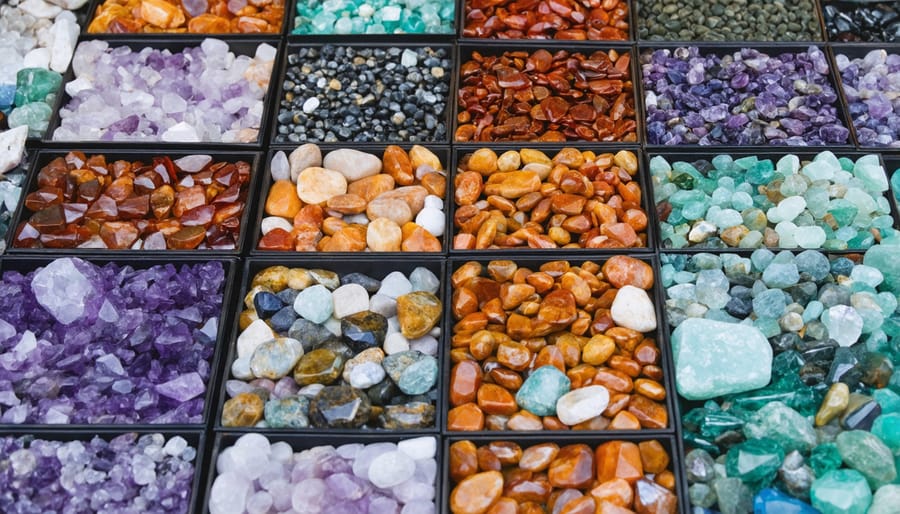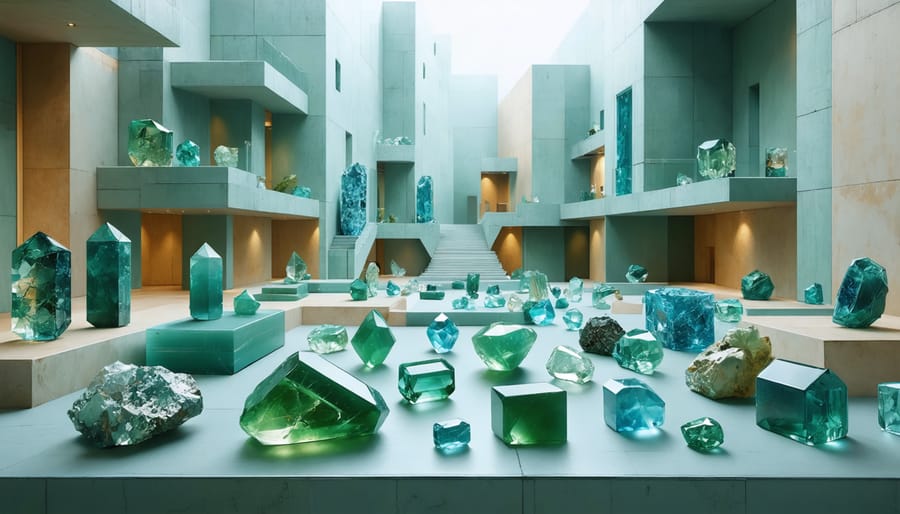Gemstones transcend their physical beauty to embody the living heritage of civilizations, serving as powerful cultural ambassadors across centuries. From the jade markets of Asia to the turquoise traditions of the American Southwest, the cultural significance of stones continues to shape global markets and design preferences.
Today’s collectors and designers recognize that understanding a gemstone’s cultural context isn’t just about appreciation—it’s essential for making informed investment decisions and creating authentic designs. Regional variations in stone preferences reveal fascinating patterns: while rubies command premium prices in Asian markets due to their association with prosperity, Mediterranean cultures historically favored deep blue sapphires for their protective properties.
This intricate relationship between culture and commerce creates unique opportunities in the natural stone market. Whether you’re a designer seeking to incorporate meaningful elements into your projects or a collector looking to build a culturally significant portfolio, these geological treasures offer more than mere aesthetic appeal—they carry stories, traditions, and values that resonate across generations.
Regional Gemstones: More Than Just Precious Stones
From Mine to Monument
The journey of a gemstone from its natural state to a cherished cultural symbol is a testament to human craftsmanship and ingenuity. Local artisans, drawing from ancient stone cutting techniques, transform raw minerals into stunning works of art that capture their region’s heritage. This transformation process typically begins with careful extraction, where miners use specialized tools to preserve the stone’s integrity while removing it from its geological home.
Once extracted, master craftsmen evaluate each piece for its unique characteristics, including color, clarity, and potential cultural significance. The cutting and polishing phases require incredible precision, with artisans often spending weeks perfecting a single stone’s form. These skilled workers don’t just shape stones; they breathe life into cultural narratives, creating pieces that embody local traditions and historical meanings.
Many of these gems ultimately find their way into significant cultural monuments, religious artifacts, and ceremonial jewelry, where they continue to tell stories of their origins and the communities that cherish them. This evolution from raw material to cultural icon represents a perfect fusion of natural beauty and human artistic expression.
Traditional Trading Routes and Modern Markets
The ancient Silk Road and maritime trade routes played a pivotal role in establishing the stone trade networks we see today. From the lapis lazuli paths connecting Afghanistan to Egypt, to the jade routes linking China with Southeast Asia, these historical channels laid the foundation for modern stone commerce.
Today’s stone markets still follow many of these traditional pathways, though now enhanced by modern logistics and digital trading platforms. Major stone trading hubs like Hong Kong, Bangkok, and Dubai serve as contemporary crossroads, connecting traditional source regions with global buyers. These markets blend centuries-old trading practices with modern quality assessment methods and sustainable sourcing protocols.
The cultural significance of certain stones continues to influence market dynamics. For instance, jade’s importance in Asian cultures maintains strong trading relationships between Myanmar and China, while the Mediterranean marble trade reflects patterns established by Roman builders thousands of years ago. This cultural heritage not only shapes price points and demand but also influences contemporary design trends and architectural applications across different regions.
Understanding these historical connections helps industry professionals better navigate today’s market dynamics and appreciate the cultural value embedded in every stone transaction.

Cultural Impact on Stone Selection
Regional Color Preferences
Color preferences in stone selection vary dramatically across different regions and cultures, often reflecting deeply-rooted cultural symbolism and traditional values. In Asian markets, jade’s green hue holds particular significance, symbolizing wisdom and eternity in Chinese culture, while pure white marble is highly valued in Middle Eastern architecture for its associations with purity and divine beauty.
Western European preferences often lean toward warm, honey-colored stones like travertine and limestone, reflecting the historical architecture of Mediterranean regions. In contrast, Scandinavian designs frequently incorporate gray and black stones, mirroring the natural landscape and minimalist aesthetic prevalent in Nordic cultures.
In India, rich, vibrant stones like red granite and golden sandstone dominate traditional architecture, representing prosperity and spiritual significance. African cultures often favor earth-toned stones that echo the continent’s diverse landscape, with brown and rust-colored stones being particularly popular in both traditional and contemporary designs.
These cultural associations significantly impact international stone trading patterns. For instance, certain pink granites command premium prices in Japanese markets due to their cultural significance, while deep black granite remains in high demand across North American commercial projects for its association with luxury and sophistication.
Understanding these regional color preferences is crucial for architects and designers working on international projects, as it helps ensure their stone selections resonate with local cultural values while meeting aesthetic expectations.
Traditional Patterns and Modern Applications
Traditional gemstone patterns continue to influence modern design in fascinating ways, seamlessly bridging ancient cultural heritage with contemporary aesthetics. These stone-inspired artistic patterns can be found in everything from luxury hotel lobbies to residential accent walls.
Notable examples include the adaptation of Indian mandala patterns in contemporary floor inlays, where precision-cut marble pieces create intricate geometric designs that honor traditional motifs while incorporating modern color palettes. Middle Eastern arabesque patterns have found new life in laser-cut stone screening panels, offering both privacy and artistic expression in modern architectural applications.
Chinese jade carving techniques now influence digital fabrication methods, allowing designers to replicate complex traditional patterns with unprecedented accuracy. These adaptations maintain cultural authenticity while meeting modern construction standards and installation requirements.
Mediterranean mosaic traditions have evolved into modular stone tile systems that allow for easier installation while preserving the visual complexity of historical designs. Japanese stone garden principles are being reimagined in corporate landscapes, where traditional elements merge with sustainable design practices.
This fusion of old and new demonstrates how cultural heritage can remain relevant and vibrant in contemporary design, ensuring these valuable traditions continue to shape our built environment while meeting modern functional needs.

Incorporating Cultural Gems in Modern Design

Sustainable Sourcing Practices
Responsible sourcing of cultural gems requires a delicate balance between preserving heritage and meeting modern design demands. Leading suppliers now emphasize transparency in their supply chains, ensuring that stones are extracted using environmentally conscious methods while respecting local communities and their traditions.
The implementation of sustainable stone architecture practices has revolutionized how we source these precious materials. Key initiatives include working directly with local artisans, supporting fair labor practices, and implementing waste reduction programs at quarry sites.
Certification programs now validate ethical sourcing practices, with many suppliers adhering to international standards for environmental stewardship and social responsibility. These programs track stones from extraction to installation, ensuring authenticity and responsible handling throughout the supply chain.
Modern technology plays a crucial role in sustainable sourcing. Advanced quarrying techniques minimize environmental impact while maximizing yield, and digital tracking systems ensure transparency in stone origin and processing. This technological integration helps preserve traditional knowledge while meeting contemporary sustainability standards.
Successful sourcing practices also involve giving back to source communities through education programs, infrastructure development, and preservation of local crafting techniques. This approach ensures that cultural gems continue to benefit their regions of origin while serving modern architectural and design needs.
Design Integration Techniques
Integrating cultural gems into modern architectural designs requires a thoughtful balance between tradition and contemporary aesthetics. Start by identifying focal points where these elements can make the strongest impact, such as entryways, accent walls, or central gathering spaces. Consider incorporating locally-sourced stones that reflect regional heritage, creating an authentic connection to the area’s cultural identity.
Layer different textures and patterns inspired by traditional motifs, but execute them using modern cutting and installation techniques. For instance, ancient mosaic patterns can be reimagined using precision-cut stone pieces arranged in contemporary geometric layouts. Combine cultural gems with complementary materials like glass, metal, or wood to create a harmonious blend of old and new.
Lighting plays a crucial role in highlighting these cultural elements. Use strategic illumination to enhance the natural properties of gemstones and create dramatic shadows that emphasize traditional patterns. Consider incorporating traditional stone-working techniques in unexpected ways, such as using hand-carved details in otherwise minimalist spaces.
For optimal integration, maintain a consistent color palette that ties cultural elements to the overall design scheme. Use cultural gems as statement pieces rather than overwhelming the space. This approach ensures these elements enhance rather than dominate the design, creating spaces that honor heritage while embracing modern functionality and style.
Understanding the cultural significance of natural stones goes far beyond their aesthetic appeal or material properties. Throughout history, different cultures have imbued specific stones with deep meaning, creating a rich tapestry of traditions that continue to influence modern stone selection and trading practices.
When choosing stones for architectural projects or design applications, considering these cultural aspects can add meaningful layers to the final result. What might be considered a premium stone in one region could hold sacred value in another, requiring careful consideration in its application and sourcing.
This cultural awareness is particularly crucial for industry professionals working in global markets. Understanding local traditions, beliefs, and preferences around specific stones can facilitate better business relationships and lead to more culturally sensitive design choices. It also helps preserve important cultural heritage while advancing modern applications of natural stone.
As the natural stone industry continues to evolve, maintaining respect for these cultural connections ensures that we not only create beautiful spaces but also honor the rich historical significance these materials carry across different societies and generations.










